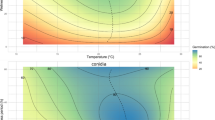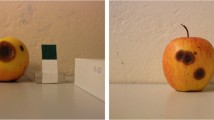Abstract
European Canker and Neonectria fruit rot (NFR), caused by Neonectria ditissima, has become a major problem for the production of apples (Malus domestica) in Brazil. This study characterized environmental factors affecting in vitro growth and germination of Neonectria ditissima as well as infection, colonization and reproduction, ex vivo, on ‘Gala’ and ‘Eva’ fruit. Temperatures between 17 to 20 °C were optimum for mycelial growth, and minimal growth occurred at 35 °C. Micro/macroconidia sporulation ratio was lower at 10 °C for most of the isolates tested, and no macroconidia were produced at 30 °C. More than 70% of conidia germinated after 12 h of exposure to constant humidity incubation and a temperature of 25 °C. Germination rate as high as 90% occurred after 48 h regardless of the temperature. Incubation of 2 h with high humidity is not sufficient for germination of 10% of conidia at any temperature between 10 to 30 °C. The cultivars Eva and Gala did not differ in relation to incubation period. A minimum of 25 days was necessary for sporulation on fruit incubated at 16.8–21.7 °C. Unwounded fruit did not present symptoms even 40 days after inoculation on intact epidermis, demonstrating the need of wounds for NFR development.





Similar content being viewed by others
References
Alves SAM, Czermainski ABC (2015) Controle do Cancro Europeu das Pomáceas com Base no Novo Ciclo Neonectria ditissima – Macieira, nas Condições do Brasil. Comunicado Técnico. Embrapa, n 178
Alves SAM, Nunes CC (2017) Seasonal susceptibility of apple trees to Neonectria ditissima wound infections. New Zealand Plant Protection 70:73–77
Bassanezzi RB, Amorim L, Bergamin Filho A, Hau B (1998) Effects of bean line pattern mosaic virus on the monocyclic components of rust and angular leaf spot of Phaseolus bean at different temperatures. Plant Pathology 47: 289-298
Beresford RM, Kim KS (2011) Identification of regional climatic conditions favorable for development of European canker of apple. Phytopathology 101:135–146
Brasil (2013) Ministério da Agricultura, Pecuária e Abastecimento. Gabinete do Ministro. Instrução Normativa n° 20, de 20 de junho de 2013. Diário Oficial da União, 21 jun. 2013. Seção 1, p. 22. Avaliable in: <http://pesquisa.in.gov.br/imprensa/jsp/visualiza/index.jsp?data=21/06/2013&jornal=1&pagina=22&totalArquivos=168>
Brown AE, Swinburne TR (1971) Benzoic acid: an antifungal compound formed in Bramley’s seedling apple fruit following infection by Nectria galligena Bres. Physiological Plant Pathology 1:469–475
Campbell RE, Chevalier CE, Touron A, Walter M (2018) The effect of nitrogen source on in vitro growth of Neonectria ditissima (European canker). New Zealand Plant Protection 71:180–188
FAOSTAT (2014) FAO: Food and Agriculture Organization of the United Nations. Available in: <http://www.fao.org.br> Access in: 4 feb 2017
Hauagge R, Tsuneta M (1999) IAPAR 75 - 'Eva', IAPAR 76 - 'Anabela' e IAPAR 77 - 'Carícia' - Novas cultivares de macieira com baixa necessidade em frio. Revista Brasileira de Fruticultura 21:239–242
Latorre B, Rioja M, Lillo C, Muñoz M (2002) The effect of temperature and wetness duration on infection and a warning system for European canker (Nectria galligena) of apple in Chile. Crop Protection 21:285–291
Maxin P, Williams M, Weber RWS (2014) Control of fungal storage rots of apples by hot-water treatments: a northern European perspective. Erwerbs-Obstbau 56:25–34
Moreira RR, Peres NA, May De Mio LL (2018) Colletotrichum acutatum and C. gloeosporioides species complexes associated with apple in Brazil. Plant Disease 103:268–275
Noble JP, Drisdale RB (1983) The role of benzoic acid and phenolic compounds in latency in fruit of two apple cultivars infected with Pezicula malicorticis or Nectria galligena. Physiological Plant Pathology 23:207–216
Oliveira DL, Alvarenga AA, Gonçalves ED, Abrahão E, Zambon CR & Norberto PM (2011) Maçã 'Eva' desponta a produção no estado de Minas Gerais. Belo Horizonte, EPAMIG. 4p. (Circular Técnica, 141)
Petri JL, Leite GB, Couto M, Francescatto P (2011) Avanços na cultura da macieira no Brasil. Revista Brasileira de Fruticultura 33:48–56
Prusky D (1996) Quiescent infections by postharvest pathogens. Annual Review of Phytopathology 34: 413-434
R Core Team (2016) R: A Language and Environment for Statistical Computing. R Foundation for Statistical Computing, Vienna, Austria. Available in: https://www.R-project.org/
Scheper RWA, Fisher BM, Amponsah NT, Walter M (2014) Effect of culture medium, light and air circulation on sporulation of Neonectria ditissima. New Zealand Plant Protection 67:123–132
Seng JM, Saindrenan P, Bompeix G (1985) Induction of Nectria galligena mutants resistant to benzoic acid and study of their aggressiveness towards immature apples. Journal of General Microbiology 131:1863–1866
Sutton TB, Aldwinckle H, Agnello A, Walgenbach JF (2014) Compendium of apple and pear diseases and pests. American Phytopathological Society, St. Paul, 343pp
Swinburne TR (1971) The infection of apples, cv. Bramley’s seedling, by Nectria galligena Bres. Annals of Applied Biology 68:253–262
Swinburne TR (1973) The resistance of immature Bramley's seedling apples to rotting by Nectria galligena Bres. In Fungal pathogenicity and the Plant's response (ed. R.]. W. Byrde and C. V. Cutting), pp. 365–382. London: Academic Press
Swinburne TR (1974) The effect of store conditions on the rotting of apples, cv. Bramley's seedling, by Nectria galligena. Annals of Applied Biology 78:39–48
Swinburne TR (1975) European canker of apple (Nectria galligena). Review of Plant Pathology 54:787–799
Weber RWS (2014) Biology and control of the apple canker fungus, Neonectria ditissima (syn. N. galligena) from a northwestern European perspective. Erwerbs-Obstbau 56:95–107
Weber RWS, Dralle N (2013) Fungi associated with blossom-end rot of apples in Germany. European Journal of Horticultural Science 78:97–105
Xu X-M, Robinson JD (2010) Effects of fruit maturity and wetness on the infection of apple fruit by Neonectria galligena. Plant Pathology 59:542–547
Zeller SM (1926) European canker of pomaceous fruit trees. Oregon Agricultural College Station Bulletin 222:1–52
Acknowledgements
The authors would like to acknowledge grants provided by the Coordination of Improvement of Higher-Level Personnel (Coordenação de Aperfeiçoamento de Pessoal de Nível Superior - CAPES) under the number 40001016031P6 and Embrapa Uva e Vinho personnel for providing the isolates and technical support.
Author information
Authors and Affiliations
Corresponding author
Ethics declarations
Conflict of interest
On behalf of all authors, the corresponding author states that there is no conflict of interest.
Additional information
Section Editor: Juan Antonio A. Navas-Cortés
Publisher’s note
Springer Nature remains neutral with regard to jurisdictional claims in published maps and institutional affiliations.
Rights and permissions
About this article
Cite this article
Gelain, J., Alves, S.A.M., Moreira, R.R. et al. Neonectria ditissima physiological traits and susceptibility of ‘Gala’ and ‘Eva’ detached apple fruit. Trop. plant pathol. 45, 25–33 (2020). https://doi.org/10.1007/s40858-019-00314-y
Received:
Revised:
Accepted:
Published:
Issue Date:
DOI: https://doi.org/10.1007/s40858-019-00314-y




